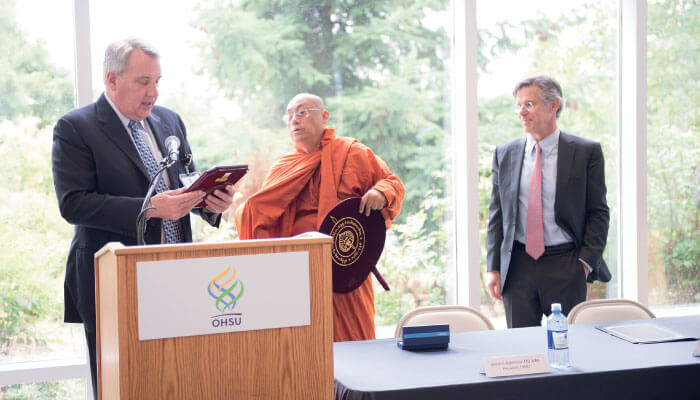
At a Glance
- The Casey Eye Institute has partnered with Siriraj Medical School and the Mandalay Eye & ENT Hospital to improve eye care in
- The program – led by Mitchell Brinks and Yee Yee Aung– has links with four medical institutes in Southeast Asia: two in Myanmar; the Mandalay Eye and ENT Hospital and Shwe Yatu Tipitaka Eye Hospital, and two in Thailand; the Siriraj Medical School and BDMS/Bangkok Hospital System
- Alongside Ophthalmic Specialty Fellowships,, the program offers mid-level personnel training, biomedical engineer training, pediatric screening, training for an Ocularist, Echographer, an improved health database and research capacity development
- The Casey/Myanmar partnership program has grown along with outreach partnerships in the South Pacific and the USA, as the team builds on its outreach programs in Oregon.
International outreach first caught my interest in medical school, as I mapped out my career goals. I wanted an enjoyable rewarding career – and I knew that couldn’t be measured in salary or surgical volume alone. I wanted to make an impact – and what could be more impactful than working with ophthalmologists in communities in the greatest need for our skills.
The more I thought about it, the more international outreach seemed to offer the ideal solution: a chance to give my fellow humans one of life’s greatest gifts – sight – and interact with people and cultures from all over the world. I knew then what I wanted to do. Since graduating, I’ve worked with underserved communities everywhere from Oregon, Washington and Alaska to Samoa, Cambodia, Bhutan and East Timor. I went on to become Assistant Professor of Ophthalmology at the Casey Eye Institute and, eventually, Director of the Casey International and Domestic Ophthalmology programs.
Five years ago, our faculty set our sights on an international, long-term partnership that best leveraged our institutional capacity. After an international search, we settled on a location – one of the poorest countries of Southeast Asia: Myanmar. Though Myanmar is a resource-rich country, more than a third of the population lives in poverty. It has one of the highest prevalence of blindness in the region, with a quarter million people blind from operable cataract alone.
To put that in context, just a few years ago fewer than ten subspecialists served a population of 55 million – one oculoplastic, one retina, two cornea and two pediatric. While generous international partners from around the globe are now opening training opportunities for the many talented Myanmar ophthalmologists, there was no Myanmar run program in place to train subspecialist. We decided, as an institute, that the best way to make change was to start from the ground up.
What started as a glaucoma and oculoplastic skills transfer has developed into an altogether different task: assisting the growth of a nascent academic ophthalmology institution, and helping talented and committed local doctors build their vision of eye care of Northern Myanmar.
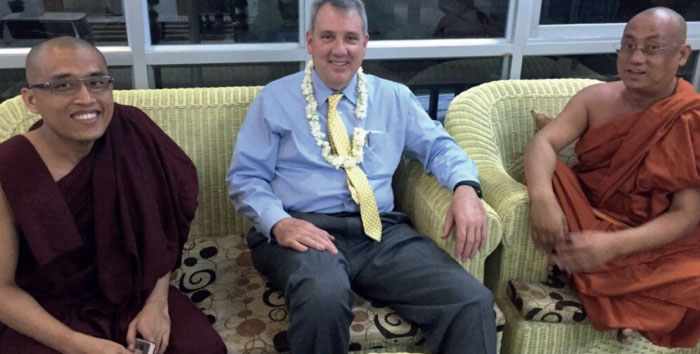
Today, the program in Mandalay incorporates many components of an effective US-based institution – including subspecialists training junior faculty, ophthalmology residency development, academic research mentorship, and management development. It also includes staff training in data management, biomedical engineering, echography, Ocularist training, clinical technical work, and population eye health outreach. The project is now in its fifth year, and growing by the day.
I can’t help but think how the program came to be. We knew we wanted to create a long-term plan with our partners in Myanmar and Thailand, but we weren’t exactly sure what form it would take and that had to change. We were asking our colleagues to commit for the rest of their careers so we had to be sure of what we were doing.
Short-term missions were an option but they didn’t resonate with our career goals; we knew we were capable of more. In the end, we spent over a year sorting through what would become the foundation of our efforts: an education program that allowed us to replicate what we do at our university institution, elsewhere in the world. But, to do that, we needed help.
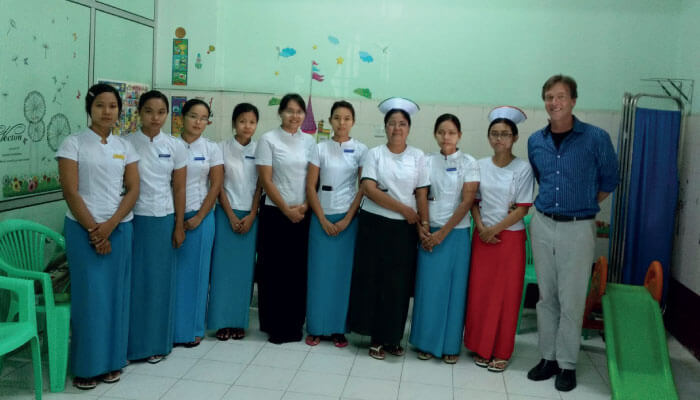
Using our partner Bangkok Hospital as our base, we visited many academic centers and government hospitals throughout Southeast Asia until we found a structured and well-led training program that matched our program. In the end, we found two and they both became our program partners. The first was the Mandalay Eye, Ear, Nose and Throat Hospital, a government-run institution with a small faculty and residency program. The second partner site in Myanmar was a Buddhist monastery, Tipitaka Eye Hospital – literally the “Three Baskets” of Buddhist scriptures. It was led by a highly respected Sayadaw, or senior monk who had memorized the entire Buddhist literature – one of just a few in the whole country.
The monastery hospital was, and is growing rapidly, giving our partnership the chance to help build new programs and bolster patient care. The government hospital was a different story. It was already well established and, as a result, a bit less agile. Though I don’t claim to be any kind of expert on Burmese culture or politics, I understand that in any international interaction, it takes a long time for both sides to build trust – and that’s even more the case in a place like Myanmar where there has been an uncertain reception for bold ideas in the past. This seems to have changed and we’ve witnessed strong investment in health care and schools over the past few years.
So, in our project we adopted a slow growth strategy. We initiated meetings with different tiers of our respective intuitions – from ophthalmologists to technicians to instructors – all the way up to the ophthalmology chair and president of our university. It was our way of guaranteeing vertical adhesion to the system on both sides. Of course, there were still niggles. We were aware that without a practical financial give-and-take basis for the relationship there may be less of an incentive to carry on. And that’s why we worked with our partner sites to formalize and carefully delineate our plan in contract form. We all wanted to be clear on the plan and know how we would solve obstacles cooperatively, when they inevitable came to pass. Still, we knew we were asking a great deal from our partners. We were demanding their time, their trainees and their attention drawn away from their very heavy workload to engage with us during visits.
At least one year went by before the overall cadre of ophthalmologists involved (both in the US and in Southeast Asia), were convinced that the partnership was worth investing in – but we did it, and the trust and capacity, is still improving today. We immediately began training sub-speciality ophthalmologists in oculo plastic surgery from the government hospital, along with developing management and operational protocols and clinical staff training programs at the monastery hospital. Everything else has grown from there.
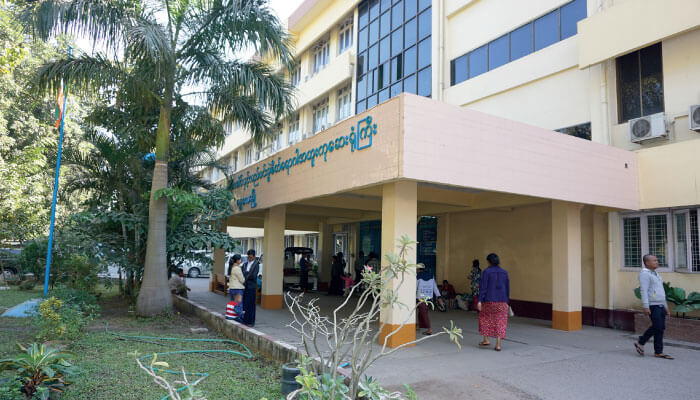
There are many ophthalmologists both from Myanmar and across the globe who choose to work for the betterment of eye care in Southeast Asia. These ophthalmologists selflessly taking on many patients, often seven days a week, and usually with little or no compensation. What they do is incredible, yet resources are can be limited – and collaboration is clearly beneficial among ophthalmologist in any country. Part of what makes long-term programs so appealing is that they give local hosts time to decide if a project is worth investing in and how they might fit in – and for visitors to better understand the local environment.
It took us years to begin to understand how social, political and medical interactions play out between foreign and Myanmar ophthalmologists– unsurprisingly, they are more complex than the same interactions would be within the USA. At the same time, our program was gaining momentum. Ophthalmologists were becoming more and more invested in our program because we intended to be there for a long time. That was it. Short-term programs are well intentioned, but they take a lot of work on behalf of the local hosts, who then have to change their clinical and O.T. times and schedule to accommodate visitors – that doesn’t happen as much with a long-term program.
By creating a sustainable project, we were allowing trust to build over time – and that applies to our own faculty, too. The project gave surgeons the chance to get to know other surgeons, trainees to get to know other trainees, and technicians to know each other. It is these personal relationships that began to drive our work.
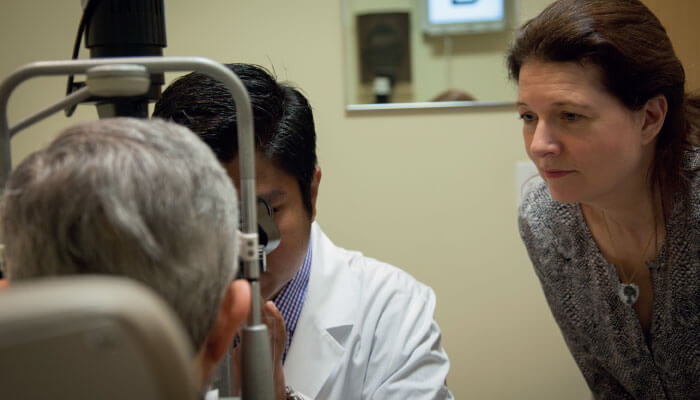
So far, our sub-specialty program has engaged in training an oculoplastic surgeon, glaucoma surgeon, vitreo retinal surgeon, uveitis specialist and neuro ophthalmologist, as well as a pediatric ophthalmologist and ophthalmic echographer. Alongside this, we’ve also helped connect our residents and are beginning to develop an academic library, enhance educational programs and understand the policy issues around non-profits working alongside us.
We’re even in the midst of training an ophthalmologist in public health, so they can take their knowledge back with them to Myanmar to steer long term planning in eye care. As you can imagine, a program of this kind – encompassing learners from different sites in a single channel – requires commitment from our team in Oregon. But it works. Why? Because our entire faculty is invested in the program. In fact, it’s become part of the identity of our eye institute!
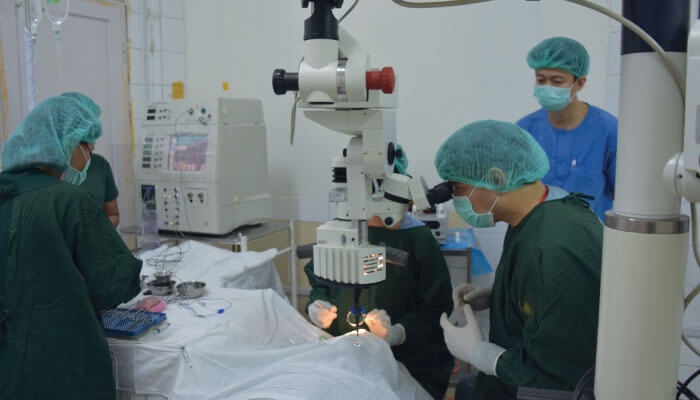
I often remind myself that where there is need, there is an opportunity to do good – and that’s a belief shared by everyone in the program, both here in Oregon, in Myanmar, in Thailand and in the South Pacific. One of our glaucoma surgeons is a good example of this. Having anticipated a meet and greet the afternoon of her arrival in Mandalay after 20 hours travel, she was asked if she would see a three year old boy with glaucoma. The boy had high pressures and the very large eyes common in advanced glaucoma. The only chance for this child was to operate without delay. Fortunately, our surgeon was also specifically trained in pediatric glaucoma.
Under normal circumstances, there would be no-one willing to operate on such a case…. but the hospital staff offered to do everything they could to make such an operation possible. The surgeon, Beth Edmunds, and the Myanmar doctors and staff were able to improvise and successfully completed the surgery in both eyes. The surgery worked – the next day the eye pressures were down, the boy’s eyes were clear and bright and his parents were delighted to see him playing with a toy car and smiling at them. It was a beautiful coming together of everything we had hoped for. Even though it was two years ago, she still hasn’t lost her enthusiasm or motivation – and it’s all because she had the opportunity to use her skills and make a difference
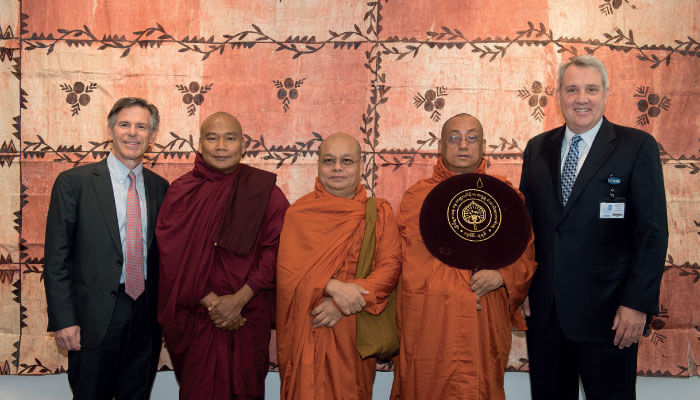
People often ask what the ultimate goal for this project is. I would say there are two. The first is to demonstrate that successful long-term partnerships can be the rule for successful and rewarding international collaborations – not the exception. Our program offers proof that it’s possible to do things on a large scale, with a modest amount of time because, in actual fact, our host and partner Myanmar ophthalmologists do the vast majority of the work – planning, supplying, organizing, seeing patients, doing surgery and managing follow up – rather than us; the visiting ophthalmologists.
But by investing our time and energy in long-term planning, we can do a lot more and feel good about it. We can clearly see that these relationships we’ve forged with colleagues in Myanmar and Thailand will remain part of our lives for many years to come. Interestingly, long-term partnerships aren’t more difficult or more expensive to set up than short-term partnerships – they just take a little more planning and preparation.
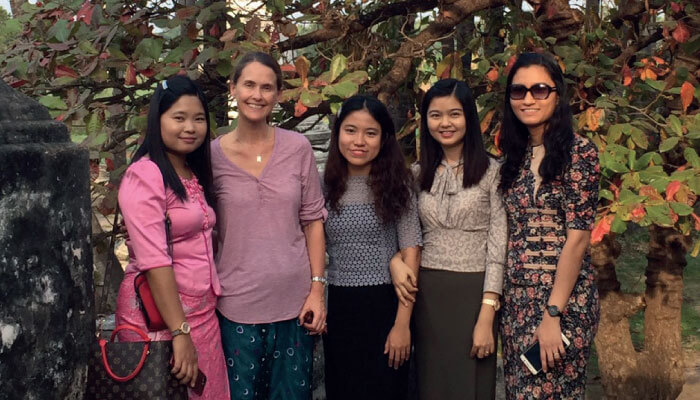
The second goal is to provide ophthalmologists with ways to get the most out of their career by delivering their skills to those who need them most. The truth is, as much as medicine is a wonderful profession, economics and bureaucratic demands can wear away at even the most dedicated physician. Programs like ours are an antidote to that. Going to a place where you can do so much for so many reminds us why we got into medicine in the first place. It helps us rediscover that original inspiration and motivation, and allows us to be creative in the way we approach certain situations.
We know that going to Myanmar can be a big step for some ophthalmologists – either because they’re new graduates, have family obligations at home or simply aren’t ready to cross so many time zones. We’ve found that our outreach program in the South Pacific, or even the one here throughout our home state of Oregon fit well for many faculty. There are quite a few people here at home who aren’t much better off than those we visit overseas. We’ve actually found that the pleasant setting and family-oriented culture of less urban locations in the Pacific islands seems to lessen the challenge of leaving home.
So that’s where we are now. As I reflect on our partnership, I can’t help but think of a moment three or four years into the Fellowship Training Program, when our team went out for dinner in Mandalay. As I looked around the table – seeing the happy cadre of young Myanmar ophthalmology specialists talking and laughing – I marveled at the self-supporting culture of talented doctors that this partnership had helped reach their goals.
Seeing this group of dedicated and talented sub-specialists – most no older than 35 – I could envision the future of tertiary eye care in Mandalay. And it looked really good.
Working Overseas
Myanmar came to the fore because of the diverse mix of like-hearted ophthalmologists willing to work together on the project. That was important because we knew that no matter how much we hashed through our plans, long-term growth would depend on the trust and respect we would build together. The ophthalmologists leading the project in Mandalay (Dr Yee Yee Aung) and Bangkok (Dr Ngamkae and Dr Somsran) are invariably thoughtful, open, and committed to the success of the project.
My team and I are currently writing a series of articles on the ethical principles around international partnerships – something every ophthalmologist working overseas has to think about. US physicians in particular are used to working in highly regulated environments. In fact, it is often these environments that allow us to produce our best work.
The problem with this lies in maintaining these supportive dynamics when we leave our home countries and go to unregulated environments. Without strict rules, people can go off track, either because they are too ambitious in their desire to help, or not self-evaluating enough to evaluate what it and is not effective care – no matter how good the intentions.
Our advice is that when people cross international boundaries, it is important they continue adhering to the principles that made them great in their own country and accept that ultimately it is the host’s country, the host’s patients and the host’s decision as to what they would like to happen. As visiting ophthalmologists, it is our job to manifest their vision, while respecting our own principals on how it should be done.
